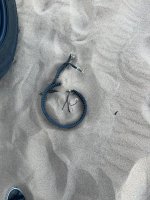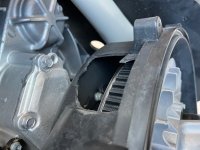onanysunday
Well-known member
- May 7, 2021
- 3,785
- 3,453
Follow along with the video below to see how to install our site as a web app on your home screen.
Note: This feature may not be available in some browsers.
Just curious, what do you drive? Never breaking a belt is impressive. I probably go through 2-3 belts a season on my X3 Max.I have never blown a belt, never had short belt life either.
Breaking in a belt is nonsense. Just go drive it. Your right foot will determine belt life along with the type of terrain you ride in. Sand will take out belts sooner then desert.I always wondered this as well.
I would do like they say and drive modestly for 20 minutes then let it cool down completely. Then being impatient I would just hammer on it after that.
I've heard some guys would put their belts in the dishwasher. They must all be single guys...
I don't really understand what it actually does, but hey, I guess it doesn't hurt to waste a little time and gas.



I enjoy you your build and trip threads so not talking chit but I just don't understand why anyone just runs belts until they blow. Once you're over 1,000 of running hard, especially in the sand you know it's on borrowed time. Why not just charge it at 1k and increase the odds of avoiding the damage of having one go on you?Breaking in a belt is nonsense. Just go drive it. Your right foot will determine belt life along with the type of terrain you ride in. Sand will take out belts sooner then desert.
I just broke a belt after 1700 miles yesterday here in Glamis. Trying to race my friend in his new Funco on the flats after a long dune run. Belt went boom at 78 mph. Lol!
I now have a nice window in my inner clutch cover.
The belt snapped, not the typical breaking into a bunch of pieces. Clutches were not crazy hot.
View attachment 27941
View attachment 27942
View attachment 27943
I wanted to gauge what mileage I can get out of the first belt. I knew I was on borrowed time for sure. Flat footing it in the flats was just asking for it. I will be changing belts out between a 1,000-1200 miles.I enjoy you your build and trip threads so not talking chit but I just don't understand why anyone just runs belts until they blow. Once you're over 1,000 of running hard, especially in the sand you know it's on borrowed time. Why not just charge it at 1k and increase the odds of avoiding the damage of having one go on you?
Don't forget to buy a new chassis at 7500 mi. :thumb:I wanted to gauge what mileage I can get out of the first belt. I knew I was on borrowed time for sure. Flat footing it in the flats was just asking for it. I will be changing belts out between a 1,000-1200 miles.
When I get to 7500 miles my Speed UTV will be here.Don't forget to buy a new chassis at 7500 mi. :thumb:
They'll be running a 2JZ by then.When I get to 7500 miles my Speed UTV will be here.
Already a Polaris with a 2jz in it. Got another Polaris with an ls1. Even seen a Subaru, Honda , and battery powered RZR. Speeds a little late to the show. Maybe they can do a turbine powered car?!!!They'll be running a 2JZ by then.
I don't know ... CVT design has been around for 500 years .. Leonardo DaVinci first came up with the idea of variable speed CVT style transmissions, and around 1900 or something they were using it for industrial machines using a belt. Go tour an old sawmill and they all have CVTs running the saws. I first started playing with them in 80's on Minibikes - The Rupp 80's designs are pretty much unchanged from today with the exception of better materials.I don’t think anyone can answer that until they are in the publics hands. But if you look at the technology Robby’s team & TAPP have spent developing just the clutches, and seeing who Speed UTV has chosen to partner with (TAPP). I would think & hope the Speed UTV clutching & belt performance would be superior to something like a Team clutch that Polaris has used for years.
The partnership with TAPP is truly a team effort. Both share patents on the clutch design. The clutches are so impressive that TAPP has been pushed into the spotlight and asked to build aftermarket clutches for the RZR & X3 through specific aftermarket clutch dealers. Those clutches don’t come with everything the Speed UTV clutch does, as their are some proprietary designs and patents that are for the Speed UTV only. If you want a TAPP aftermarket clutch just the primary will set you back around $2400.
People give RG chit for taking to long or whatever, but no one can say he’s taking the easy way. Easy would have been to partner with a current manufacture or supplier of UTV clutches. But like each part of the Speed car, Robby is building it better then what is out there now.
The Clutch is a perfect example. He originally partnered with another clutch designer who has done stuff in the UTV racing world. But that guy could not come through. In early testing his product was not holding up to the demand required. So the Speed Team again went deep outside of the UTV world, and found TAPP. These guys designs and thoughts were leaps ahead of what other CVT clutch designers were doing. But they were custom parts. Robby partnered with them and brought them into the mass production world but knowing they could not sacrificing the design and performance. Again this brought another challenge, as these clutches were full billet machined and you can’t affordability mass produce a full billet part. Casting was not going to be strong enough, so they had to find away to incorporate forging the part. Then doing finally machining on the forgings. Again that’s another example of going that extra step beyond the industry norm.
But like I said until it’s in the consumers hands will we ultimately know how much better they might be.
Unknown at this time. If the alignment is good, good ducting for airflow, and the right set up it should be good to go. You can test and test and Joe public will still find a way to break belts. Belt breakage is mostly in the dunes for us West coast and desert people.So will the Speed UTV be similar to other UTVs regarding belt reliability?
Or will it be worse because it’s heavier? Or is the Speed UTV design better making the belt last longer?
EVO has a helix you can adjust easily.Shocks absorbers were invented in 1907. I would not say a shock is still a shock. I’d say those have developed allot since then and even today they are evolving, just in the off road world alone. Rick Hasselo made the first bypass tube for Micky Thompson in the early 80’s. No one had any idea what the hell that tube was. But the mid 80’s a select few and not just the big dogs had tubes. They were very crude by todays standards of check valves and springs. Now we have electronics controlling our shocks.
So just because the CVT has been around forever in several different applications, does not mean someone can’t or has not created a better one using a different concept then what you typically would see.
How many have the internal adjustable cams to change the ramp angle of the weights making the CVT fully adjustable without having to manually change the weights or adding washers or bolts to the end of the weights to make clutch changes? None that I have seen before the TAPP clutch.
As far as alignment. Robby has come up with a fix for that by intergrading the cover into a tie bar which creates a double shear support and holds the two clutches in alinement at all times. This extra support also takes that huge rotating mass hanging off the crank shaft and distributes the weight and load and supports it in two places. No other UTV does that.
If there is a need or desire, everything can change or be improved upon. In 1995 Amazon started selling books online. That changed how we buy things today.

